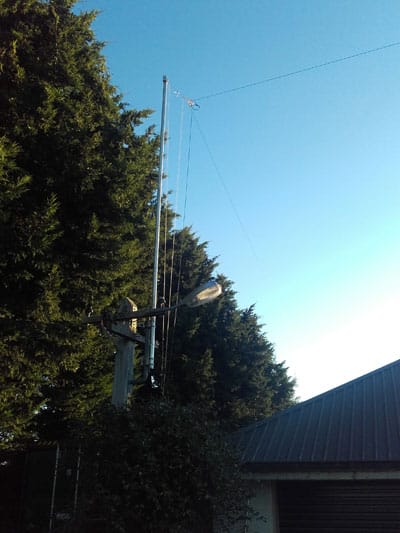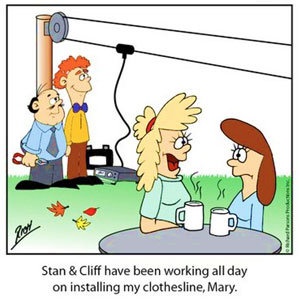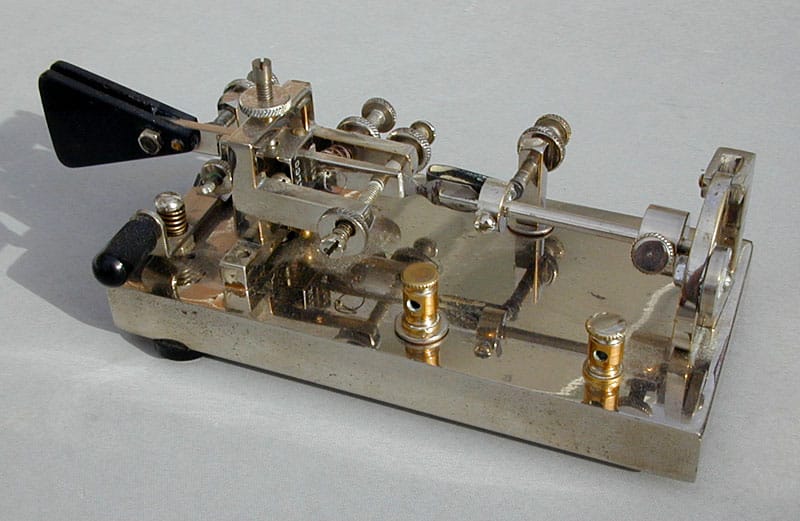This is a fortnightly newsletter about the New Zealand Net.
If you would like to be notified by email message when a new edition is published, please contact ZL1NZ.
You are also welcome to browse our newsletter archive.
Whose aerial?

Well, it’s been a while since we featured a “mystery aerial” but here’s a photo of one that I received recently from an NZ Net member.
Can you guess whose it is?
It’s an 80m dipole.
The owner explains: “That’s my own private power pole with streetlight. I haven’t ‘borrowed’ a Council one!”
One more clue: This OM has operated amateur radio from Scott Base, Antarctica!
Here’s the answer.
Quick notes

Busy times on the Net! We’ve been getting 8-10 check-ins to the Net most recent evenings, even with some high noise levels. A new monthly record is possible if we keep it up!
Grant ZL2GD took a check-in during the 18 August NZ Net from Hector LU1YFC in the Andes mountains of Argentina. Thanks for joining us Hector!
Congratulations to Paul ZL1AJY on his article in the latest Break-In about the ZL1XH Field Day operation. Strangely, Break-In credited the article to me (Neil ZL1NZ), but it was definitely Paul’s work! On the magazine cover is a photo taken in the ZL1XH 80m tent, showing a very handsome pair of keys: a WT 8 Amp No. 2 Mk II, for the slower contacts, and a Bencher ST-1 single-lever paddle (see last newsletter for more info on Bencher keys).
This year’s Sangster Shield QRP CW contest included a lot of NZ Net stations: ZL1PC (1st place), ZL1XH (aka ZL1AJY), ZL2GD, ZL2LN, ZL4FZ, ZL1BWG, and ZL2GVA. Full results are in the latest Break-In.
Scrambled signals: Swinging fists
I think radio amateurs are lucky. If we tune across the bands and hear a Morse fist that only a mother could love, we can just keep tuning until we find something that’s easier to copy!
Not so for the professional radio operator, who had to copy whatever was sent. Some fists were “machine-quality” while others were full of swing (non-standard dot-dash ratios) or perhaps lacked the proper spacing between characters and words.
Let’s give a listen to this very short recording of an exchange, probably from the 1980s. I’ll award a virtual chocolate fish to the first person to email me with an accurate copy of what the two ops were saying to each other. Just for fun, let me know how many times you had to listen to the recording. 🙂
I’ll give you two clues: it was recorded in New Zealand on a marine frequency.
Congratulations to Don ZL2LDX who was the first person to contact me with a correct answer to the question in the last newsletter, “what is the meaning of the prosign <VGI>?” The answer (which I’m glad no one tried to send me on the air) is that it’s simply another way of representing the prosign we customarily write as <SOS>, meaning “I am in distress.” Don gets the virtual chocolate fish. Others with the correct answer were ZL1ANY, ZL1AYN and ZL1BWG.
Featured key: Wilcox bug

Here’s an interesting key, that I imagine few will have encountered. As you can see, it’s got plenty of “bling” (is that still a term these days?). Nickel-plated and with a nice thick (heavy) base, this is a Wilcox bug, made in Toronto close to a hundred years ago.
Fred Wilcox had worked for another bug-maker, Rolph Brown, famed for his Xograph keys, so there’s a lot of bug history here, some of which is on this webpage.
I’m pretty sure I was given this key when, as a teenager, I bought an old National receiver in Toronto. It was a lucky bonus, as these keys are pretty rare, and I’m glad to still have it.
Got a key you’d like to show off? Email me a photo and description.
Morse musings: why do we send “dit dit”?
The end-of-qso exchange is said to have evolved from the musical phrase “shave and a haircut – two bits”. (Two bits was slang for 25 cents.)
One operator would send “E S E” (“shave and a haircut”) and the other would respond with “E E” (“two bits”). Nowadays we all lead busy lives, so we save time by having both ops send only the “E E”. 🙂
But where did “shave and a haircut” come from? Some of the answer is in this video…
Net tip: Making messages that are easy to copy
I thought it might be time for a quick review of the basics of message formatting, especially for our newer net members.
I recommend using a message form, such as the ones you can download free here.
A message ALWAYS has FOUR parts, and the parts are separated by ONE double-dash <BT>, like this:
HEADER (PREAMBLE) = ADDRESS = BODY TEXT = SIGNATURE
There are ALWAYS THREE double-dashes in a message (the ones shown above). If you add more, it’s really going to confuse the receiving operator.
In fact, punctuation isn’t generally used at all in a radiogram. Instead, we spell out things such as “STOP”, “COMMA” and “QUERY”. If we were to use ordinary punctuation symbols, it would become difficult to reconcile the word count with the check number.
Here’s a good example of a radiogram that is extremely easy to copy. Notice the use of = to separate the four sections of the message, and also observe how David ZL2WT chose to convey the number contained in the body text in a way that was easy for the receiving operator to understand.
It’s not compulsory to spell out numbers, and you can even use a decimal point (di-dah-dit) if your spacing is perfect (so the word count is unambiguous) but the way David chose to send it was pretty much fool-proof.
For those who are wondering about this message, it was the answer to our latest NZ Net Trivia question, “which frequency in MHz has the same number for its wavelength in metres?” The answer, of course, is the square root of 299.792458 (or 300 if you’re less precise than David). 🙂
Suggestions?
If you have suggestions on how to make the NZ Net better, or things you’d like to see covered in these updates, please contact ZL1NZ. You might even like to write something for the newsletter.
Thanks for reading, and I hope to see you soon on the NZ Net!
—
Neil Sanderson ZL1NZ, Net Manager
New Zealand Net (NZ NET)
3535.0 kHz at 9pm NZT Mon-Fri



